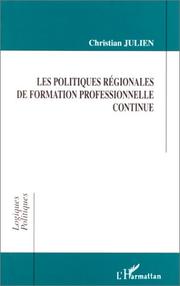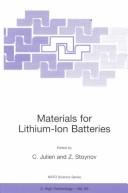| Listing 1 - 10 of 10 |
Sort by
|

ISBN: 2738467083 Year: 1998 Publisher: Paris : L'Harmattan,
Abstract | Keywords | Export | Availability | Bookmark
 Loading...
Loading...Choose an application
- Reference Manager
- EndNote
- RefWorks (Direct export to RefWorks)
Occupational training --- Formation professionnelle --- Local governement --- Gouvernement local --- Continuing education --- Regional disparities.
Book
Year: 1966 Publisher: Paris A. G. E. M. P
Abstract | Keywords | Export | Availability | Bookmark
 Loading...
Loading...Choose an application
- Reference Manager
- EndNote
- RefWorks (Direct export to RefWorks)
Book
Year: 2004 Publisher: Rungis : COLEACP. Programme Initiative Pesticides,
Abstract | Keywords | Export | Availability | Bookmark
 Loading...
Loading...Choose an application
- Reference Manager
- EndNote
- RefWorks (Direct export to RefWorks)
Food hygiene --- Food hygiene --- Certification --- Certification --- Regulations --- Regulations --- Management by objectives --- Management by objectives --- ACP --- ACP --- design --- design --- Europe --- Europe
Book
Year: 2004 Publisher: Rungis : COLEACP. Pesticides Initiative Programme,
Abstract | Keywords | Export | Availability | Bookmark
 Loading...
Loading...Choose an application
- Reference Manager
- EndNote
- RefWorks (Direct export to RefWorks)
Food hygiene --- Food hygiene --- Certification --- Certification --- Regulations --- Regulations --- Management by objectives --- Management by objectives --- ACP --- ACP --- design --- design --- Europe --- Europe

ISBN: 0792366514 0792366506 Year: 2000 Publisher: Dordrecht : Kluwer,
Abstract | Keywords | Export | Availability | Bookmark
 Loading...
Loading...Choose an application
- Reference Manager
- EndNote
- RefWorks (Direct export to RefWorks)
LITHIUM PRIMARY BATTERIES --- LITHIUM COMPOUNDS --- USES --- LITHIUM PRIMARY BATTERIES --- LITHIUM COMPOUNDS --- USES
Book
Year: 2004 Publisher: Rungis : COLEACP. Pesticides Initiative Programme,
Abstract | Keywords | Export | Availability | Bookmark
 Loading...
Loading...Choose an application
- Reference Manager
- EndNote
- RefWorks (Direct export to RefWorks)
Food hygiene --- Food hygiene --- Certification --- Certification --- Regulations --- Regulations --- Management by objectives --- Management by objectives --- ACP --- ACP --- Europe --- Europe
Book
Year: 2004 Publisher: Rungis : COLEACP. Programme Initiative Pesticides,
Abstract | Keywords | Export | Availability | Bookmark
 Loading...
Loading...Choose an application
- Reference Manager
- EndNote
- RefWorks (Direct export to RefWorks)
Food hygiene --- Food hygiene --- Certification --- Certification --- Regulations --- Regulations --- Management by objectives --- Management by objectives --- ACP --- ACP --- Europe --- Europe
Book
ISBN: 3319191071 331919108X Year: 2016 Publisher: Cham : Springer International Publishing : Imprint: Springer,
Abstract | Keywords | Export | Availability | Bookmark
 Loading...
Loading...Choose an application
- Reference Manager
- EndNote
- RefWorks (Direct export to RefWorks)
The book focuses on the solid-state physics, chemistry and electrochemistry that are needed to grasp the technology of and research on high-power Lithium batteries. After an exposition of fundamentals of lithium batteries, it includes experimental techniques used to characterize electrode materials, and a comprehensive analysis of the structural, physical, and chemical properties necessary to insure quality control in production. The different properties specific to each component of the batteries are discussed in order to offer manufacturers the capability to choose which kind of battery should be used: which compromise between power and energy density and which compromise between energy and safety should be made, and for which cycling life. Although attention is primarily on electrode materials since they are paramount in terms of battery performance and cost, different electrolytes are also reviewed in the context of safety concerns and in relation to the solid-electrolyte interface. Separators are also reviewed in light of safety issues. The book is intended not only for scientists and graduate students working on batteries but also for engineers and technologists who want to acquire a sound grounding in the fundamentals of battery science arising from the interaction of electrochemistry, solid state materials science, surfaces and interfaces.
Mechanical Engineering - General --- Mechanical Engineering --- Engineering & Applied Sciences --- Lithium ion batteries. --- Lithium cells. --- Storage batteries. --- Accumulator batteries --- Accumulators, Electric --- Batteries, Storage --- Rechargeable batteries --- Secondary batteries --- Batteries, Lithium --- Cells, Lithium --- Cells, Lithium ion --- Electrochemical cells, Lithium ion --- LIBs (Lithium ion batteries) --- Li-ion batteries --- Lithium ion cells --- Lithium ion electrochemical cells --- Electric apparatus and appliances --- Electric power supplies to apparatus --- Electric batteries --- Storage batteries --- Chemistry. --- Surfaces (Physics). --- Nanotechnology. --- Energy Storage. --- Electrochemistry. --- Characterization and Evaluation of Materials. --- Solid State Physics. --- Molecular technology --- Nanoscale technology --- High technology --- Physics --- Surface chemistry --- Surfaces (Technology) --- Physical sciences --- Energy storage. --- Materials science. --- Solid state physics. --- Solids --- Material science --- Chemistry, Physical and theoretical --- Storage of energy --- Force and energy --- Power (Mechanics) --- Flywheels --- Pulsed power systems
Digital
ISBN: 9783319191089 9783319349299 Year: 2016 Publisher: Cham Springer International Publishing
Abstract | Keywords | Export | Availability | Bookmark
 Loading...
Loading...Choose an application
- Reference Manager
- EndNote
- RefWorks (Direct export to RefWorks)
The book focuses on the solid-state physics, chemistry and electrochemistry that are needed to grasp the technology of and research on high-power Lithium batteries. After an exposition of fundamentals of lithium batteries, it includes experimental techniques used to characterize electrode materials, and a comprehensive analysis of the structural, physical, and chemical properties necessary to insure quality control in production. The different properties specific to each component of the batteries are discussed in order to offer manufacturers the capability to choose which kind of battery should be used: which compromise between power and energy density and which compromise between energy and safety should be made, and for which cycling life. Although attention is primarily on electrode materials since they are paramount in terms of battery performance and cost, different electrolytes are also reviewed in the context of safety concerns and in relation to the solid-electrolyte interface. Separators are also reviewed in light of safety issues. The book is intended not only for scientists and graduate students working on batteries but also for engineers and technologists who want to acquire a sound grounding in the fundamentals of battery science arising from the interaction of electrochemistry, solid state materials science, surfaces and interfaces.
Thermodynamics --- Solid state physics --- Electrochemistry --- Relation between energy and economics --- Materials sciences --- Electrical engineering --- Applied physical engineering --- thermodynamica --- vaste stof --- materiaalkennis --- materie (fysica) --- energie-economie --- nanotechniek --- elektrische netwerken --- energie (technologie) --- elektrolyten --- elektrochemie --- elektriciteitsdistributie
Book

ISBN: 3110495082 9783110497434 3110497433 9783110495089 9783110497342 3110497344 9783110491227 3110491222 Year: 2017 Publisher: Berlin Boston
Abstract | Keywords | Export | Availability | Bookmark
 Loading...
Loading...Choose an application
- Reference Manager
- EndNote
- RefWorks (Direct export to RefWorks)
What can we learn from nature? The study of the physical, chemical and structural properties of well-known minerals in the geo- and biosphere creates new opportunities for innovative applications in technology, environment or medicine. This book highlights today's research on outstanding minerals such as garnets used as components in all solid state batteries, delafossite formation during wastewater treatment, monazites for the immobilization of high level radioactive waste or hyroxylapatite as bioactive material for medical implant applications. Contents Part I: High-technology materials Lithium ion-conducting oxide garnets Olivine-type battery materials Natural and synthetic zeolites Microstructure analysis of chalcopyrite-type CuInSe2 and kesterite-type Cu2ZnSnSe4 absorber layers in thin film solar cells Surface-engineered silica via plasma polymer deposition Crystallographic symmetry analysis in NiTi shape memory alloys Part II: Environmental mineralogy Gold, silver, and copper in the geosphere and anthroposphere: can industrial wastewater act as an anthropogenic resource? Applied mineralogy for recovery from the accident of Fukushima Daiichi Nuclear Power Station Phosphates as safe containers for radionuclides Immobilization of high-level waste calcine (radwaste) in perovskites Titanate ceramics for high-level nuclear waste immobilization Part III: Biomineralization, biomimetics, and medical mineralogy Patterns of mineral organization in carbonate biological hard materials Sea urchin spines as role models for biological design and integrative structures Nacre: a biomineral, a natural biomaterial, and a source of bio-inspiration Hydroxylapatite coatings: applied mineralogy research in the bioceramics field A procedure to apply spectroscopic techniques in the investigation of silica-bearing industrial materials
Mineralogy. --- Mines and mineral resources. --- Crystals. --- Crystalline interfaces. --- Crystals --- Interfaces (Physical sciences) --- Crystallography --- Powders --- Solids --- Deposits, Mineral --- Mineral deposits --- Mineral resources --- Mines and mining --- Mining --- Natural resources --- Geology, Economic --- Minerals --- Physical geology
| Listing 1 - 10 of 10 |
Sort by
|

 Search
Search Feedback
Feedback About UniCat
About UniCat  Help
Help News
News